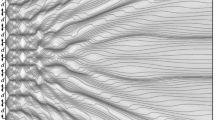Abstract
A hydrodynamic model of the Weyl–Dirac theory in the non-relativistic approach is established. Any microparticle is permanently interacting with the ‘subquantum level’ through the quantum potential, which depends only on the imaginary part of a complex speed. The complex speed fields indicate a possible connection between the Weyl–Dirac theory and Scale Relativity Theory. In such conjecture, some properties of the vacuum states result: the vacuum states behave as a superconducting state, they act as an energy accumulator etc.
Similar content being viewed by others
References
Weyl H. (1919). Ann. Phys. (Lpz.) 59: 101–105
Dirac P.A.M. (1973). Proc. R. Soc. Lond. A 333: 403–409
Israelit M. (1999). The Weyl–Dirac Theory and Our Universe. Nova, New York
Gregorash D. and Papini G. (1981). Nuovo Cimento B 63: 487–509
Wood W.R. and Papini G. (1993). J. Found. Phys. Lett. 6: 207–223
Wood W.R. and Papini G. (1992). Phys. Rev. D 45: 3617–3627
Agop M. and Nica P. (1999). Class. Quantum Grav. 16: 3367–3380
Agop M. and Nica P. (2000). Class. Quantum Grav. 17: 3627–3644
Agop M., Ioannou P.D. and Buzea C. (2001). Class. Quantum Grav. 18: 4743–4762
Bohm D. (1951). Phys. Rev. 85: 166–179
Papini G. (1990). Berry’s phase and particle interferometry in weak gravitational fields. In: Aundretsch, J. (eds) Quantum Mechanics in Curved Space-Time, pp. Plenum Press, New York
Cai Y.Q. and Papini G. (1989). Class Quant. Grav. 6: 607
Anandan J. (1977). Phys. Rev. D 15: 448
Papini G. (1970). Nuovo Cim. 68: 1
Wald R.M. (1984). General Relativity. University of Chicago Press, Chicago
Weinberg S. (1972). Gravitation and Cosmology. Wiley, New York
Synge J.L. (1964). Relativity: the General Theory. North-Holland, Amsterdam
Adler R., Bazin M. and Schiffer M. (1965). Introduction to General Relativity. McGraw-Hill, New York
‘t Hooft G. (1981). Nucl. Phys. B 315: 527–577
Nottale L. and Schneider J. (1984). J. Math. Phys. 25: 1296
Ord G. (1983). J. Phys. Math. Gen. 16: 1869
Nottale L. (1989). Int. J. Mod. Phys. 4: 5047
Nottale L. (1992). Fractal Space-Time and Microphysics, Towards a Theory of Scale Relativity. World Scientific, Singapore
Nottale L. (1996). Chaos Solitons Fractals 7: 877
Madelbrot B. (1982). The Fractal Geometry of Nature. Freeman, San Francisco
Bransden B.H. and Joachain C.J. (1994). Introduction to Quantum Mechanics. Longman Scientific and Technical, Essex
Titeica S. (1984). Quantum Mechanics. Romanian Academy Press, Bucharest
Agop M., Nica P., Ioannou P.D., Olga Malandraki and Gavanas-Pahomi I. (2007). Chaos Solitons Fractals 34: 1704
Rosen N. (1982). Found. Phys. 12: 213
Israelit M. (1997). Gen. Rel. Grav. 29: 11
Barrow J.D. and Burman R.R. (1984). Nat (Lond) 307: 14–15
Chaichian M. and Nelipa N.F. (1984). Introduction to Gauge Field Theories. Springer, Berlin
Poole C.P., Farach H.A. and Geswich R.J. (1995). Superconductivity. Academic, San Diego
Bowman F. (1953). Introduction to Elliptic Functions with Applications. English University Press, London
Toda M. (1988). Theory of Nonlinear Lattices. Springer, Berlin
Ciubotariu C. and Agop M. (1996). Gen. Rel. Grav. 28: 405–412
Kroger H. (2000). Phys Rep 323: 81–181
Goldfain E. (2006). Chaos Solitons Fractals 30: 324–331
Hawking S. and Penrose R. (1996). The Nature of Space and Time. Princeton University Press, Princeton
Penrose R. (2004). The Road to Reality: a Complete Guide to the Laws of the Universe. Jonathan Cape, London
Author information
Authors and Affiliations
Corresponding author
Rights and permissions
About this article
Cite this article
Agop, M., Nica, P. & Gîrţu, M. On the vacuum status in Weyl–Dirac theory. Gen Relativ Gravit 40, 35–55 (2008). https://doi.org/10.1007/s10714-007-0519-y
Received:
Accepted:
Published:
Issue Date:
DOI: https://doi.org/10.1007/s10714-007-0519-y



